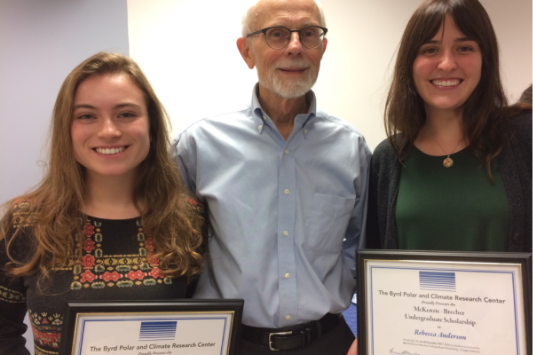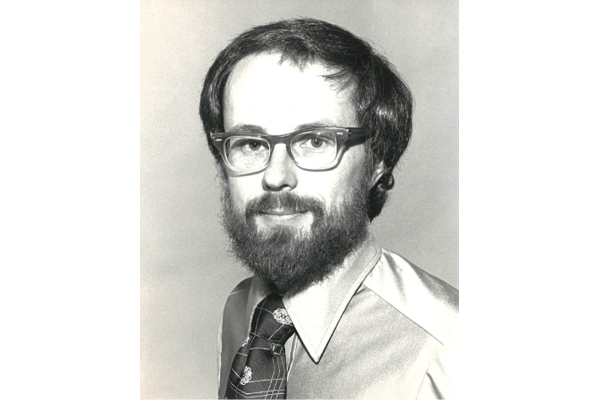— HISTORY CORNER —
How do you get a scholarship named in your honor? Be the Rock of the Classroom.
by Vigo Bertolo

Garry McKenzie began his career at Ohio State in 1968 as Assistant to the Director of the Institute of Polar Studies, now the Byrd Polar and Climate Research Center. The following year, he became an Assistant Professor in the Department of Geology and Mineralogy and was promoted to Associate Professor in 1975. Today, he holds the title of Associate Professor Emeritus at the School of Earth Sciences. Dr. McKenzie has made countless contributions to Ohio State and the broader scientific community through his research, teaching, and commitment to fostering an interdisciplinary understanding of Earth science.

Garry McKenzie was born in Niagara Falls, Canada, in 1941. He attended the University of Western Ontario in London, Ontario, where he received a Bachelor of Science degree in 1963 and a Master of Science degree in 1964. Before coming to Ohio State to pursue his PhD in 1965, he took part in the Juneau Icefield Research Program in Alaska, helping him to develop his skills in the field before starting as a doctoral student under Dr. Richard Goldthwait in the Department of Geology. In 1966, he traveled to Antarctica for the first time, where he worked as part of the Meserve Glacier Expedition in the McMurdo Dry Valleys. Dr. McKenzie went on to complete his PhD in 1968, becoming a glacial geologist after publishing his dissertation, Glacial history of Adams Inlet, southeastern Alaska. Dr. McKenzie was a committed and influential figure in the early days of the Institute of Polar Studies, which can be seen through his role as Assistant to the Director, Dr. Colin Bull, from 1968-69, where he helped to obtain funding for the Institute, along with his writing of the "History of the Institute of Polar Studies, 1960-1969," a comprehensive document that covers the first decade of the Byrd Center.
In 1981, he traveled to Antarctica once again, this time holding a 'rotator' position in the Geology Program of the National Science Foundation, Office of Polar Programs, heading south to McMurdo Station as an NSF representative during the 1981-82 season.
Throughout his career, Dr. McKenzie remained an active member of the Byrd Center by supporting and engaging with much of the research being done by his colleagues in the polar regions. Dr. Berry Lyons, former Director of the Byrd Center, recalls Dr. McKenzie's presence at Byrd, "Garry is one of these gregarious individuals; he would always be smiling and positive, and always a great joy to be around... his energy and enthusiasm were contagious." During Dr. Lyons' time as Director of the Byrd Center, the McKenzie-Brecher undergraduate scholarship was founded, and the decision for whom to name it after was clear, "The scholarship was named in honor of him (Dr. McKenzie) because of his encouragement to undergraduates to get involved in research, and go to scientific meetings, and learn as much as they could... he was a beacon of enthusiasm for all that is Earth sciences... so it was an easy choice to name it for him because he was such a flag bearer for undergraduate education." The McKenzie-Brecher scholarship continues to provide financial and scholarly support for undergraduate research projects in the spirit of Dr. McKenzie's encouragement of his students.
While a prolific geological researcher, Dr. McKenzie also turned much of his research focus to geoscience education. His wide range of interests and expertise, from geomorphology to environmental geology, led Dr. McKenzie to develop and teach a variety of undergraduate courses and even courses for middle and high school teachers, always maintaining a strong emphasis on field-based, hands-on learning. Later in his career, Dr. McKenzie gained a stronger interest in climate change and the rising field of sustainability, and he became a pioneer in the education of these subjects at Ohio State, encouraging a robust understanding of the Earth system as a means of working towards a more sustainable future.
Dr. McKenzie helped people appreciate the connections between geoscience and humanity, from its role in medicine to its influence on art. He and his colleague, Russ Utgard, edited a collection of papers in environmental geology for undergraduate students. In the preface, they wrote that "the environment cannot be studied from a narrow viewpoint," and the articles they selected dealt with "many different aspects of man's impact on the geologic environment." This approach mirrored Dr. McKenzie's own teaching philosophy, and his appreciation of the broad relevance of geology attracted students from all majors to his classes. He also advised dozens of undergraduates as they wrote their senior theses on a wide array of topics, including Earth science education for elementary school, and the role of geomorphology in historical battles.
Dr. McKenzie, along with his colleagues, developed several new Earth science courses and materials. He and Dr. Utgard wrote the first lab manual in environmental geology for a course at Ohio State, and co-wrote three geology textbooks from 1972 to 1978, including Man and his Physical Environment, Man's Finite Earth, and Geology in the Urban Environment. Dr. McKenzie also played a key role in two summer field programs that taught high-school teachers to investigate multi-disciplinary solutions to environmental problems. During his time at Ohio State, Dr. McKenzie has been involved in the development of a variety of courses which showcase his broad interests within geoscience, such as national security, climate change, and glacial deposits.
Throughout his distinguished career, Garry McKenzie dedicated himself to making Earth science accessible and engaging. His teaching, research, and leadership greatly benefited the Byrd Polar and Climate Research Center, the Ohio State School of Earth Sciences, and the countless students and educators he influenced. Cheers Garry!

References:
Dr. Garry McKenzie, School of Earth Sciences, Associate Professor Emeritus, CV on file.
Dr. Berry Lyons, Professor Emeritus, School of Earth Sciences, (January 2025), personal interview.
Dr. David Elliot, Professor Emeritus, School of Earth Sciences, (January 2025), personal interview.
Dr. Lawrence Krissek, Professor Emeritus, School of Earth Sciences, (January 2025), personal communication.
History of the Institute of Polar Studies 1960-69, June 1969.
Students awarded scholarships from Byrd Polar, School of Earth Sciences, November 2, 2017.
Glacial history of Adams Inlet, southeastern Alaska, Dr. McKenzie dissertation, Doctor of Philosophy, Ohio State University, Graduate School, 1968.
